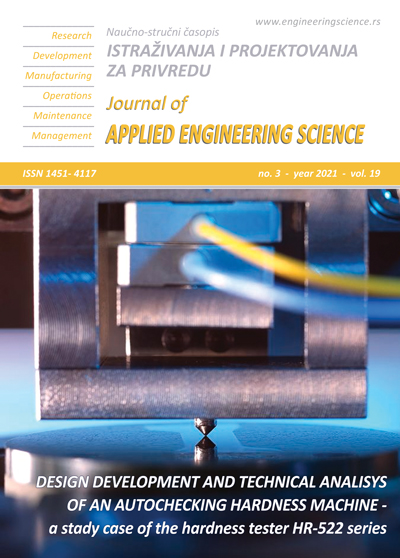SPEED CHANGE AND TRAFFIC SAFETY POWER MODEL FOR INTER-URBAN ROADS
Abstract
The aim of this study is to develop the power model of the relationship between speed and traffic safety. As the inter-urban roads are characterized with heterogenous traffic, the heterogeneity became the focus of the analysis. The present study analyzed the effects of various types of vehicles through a number of speed change combinations and developed six equations: number of fatal accidents, number of fatalities, number of fatal and serious injury accidents, number of fatal or serious injuries, number of injury accidents and number of injured road users. The results indicated that the Power Model showed high predictability of the speed-accident relationship. The models fit the data well with Rsq in the range of 0.6-0.8 when only the speed ratios adopted. The vehicle-specific ratio power models exhibited how traffic heterogeneity accounts for traffic safety. The exponents of the equations varied with the types of vehicles, indicating the different sensitivity of accident counts and casualties to the speed ratios. Overall, with the power estimates around one, except for all injured victims, the estimates were systematically smaller than those that were initially inferred in Nilsson's Power model. The values indicated that the increase in speed determined the increase in the number of accidents and casualties from year to year. The present study successfully developed the first speed-traffic safety Power Model for Indonesia. As it is exclusively dependent on the speed changes, the model can well describe the direction of change in traffic safety irrespective of other changes in the driving environment factors.
References
[2]. Gargoum, S.A., El-Basyouny, K. (2016). Exploring the Association between Speed and Safety: a Path Analysis Approach. Accident Analysis & Prevention, vol. 93, 32-40, DOI: 10.1016/j.aap.2016.04.029
[3]. Garber, N.J., Gadiraju, R. (1989). Factors affecting speed variance and its influence on accidents. Transportation Research Record, vol. 1213, 64-71.
[4]. Nilsson, G. (2004). Traffic Safety Dimensions and the Power Model to Describe the Effect of Speed on Safety. Doctoral thesis, Graduate Program, Lund University, Lund, Sweden
[5]. Elvik, R., Christensen, P., Amundsen, A. (2004). Speed and Road Accidents: an Evaluation of The Power Model TOI Report 740/2004, Institute of Transport Economics, Oslo.
[6]. Elvik, R. (2013). A Re-parameterisation of The Power Model of The Relationship between The Speed of Traffic and The Number of Accidents and Accident Victims. Accident Analysis & Prevention, vol. 50, 854-860, DOI: 10.1016/j.aap.2012.07.012
[7]. Elvik, R., Vadeby, A., Hels, T., van Schagen, I. (2019). Updated Estimates of The Relationship between Speed and Road Safety at The Aggregate and Individual Levels. Accident Analysis & Prevention, vol. 123, 114-122, DOI: 10.1016/j.aap.2018.11.014
[8]. Tanishita, M., Van Wee, B. (2016). Impact of Vehicle Speeds and Changes in Mean Speeds on per Vehicle-Kilometer Traffic Accident Rates in Japan. IATSS research, vol. 41, no. 3, 107-112, DOI: 10.1016/j.iatssr.2016.09.003
[9]. Wang, X., Zhou, Q., Quddus, M. and Fan, T. (2018). Speed, Speed Variation and Crash Relationships for Urban Arterials. Accident Analysis & Prevention, vol. 113, 236-243, DOI: 10.1016/j.aap.2018.01.032
[10]. Roy, R., Saha, P., Sarkar, A.K. (2017). Speed Distributional Trends on Two-Lane Roads with Mixed Traffic under Heavy Flow. Procedia engineering, vol. 187, p. 465-470.
[11]. Dhamaniya, A., Chandra, S. (2013). Speed Characteristics of Mixed Traffic Flow on Urban Arterials. International Journal of Civil, Architectural Science and Engineering, vol. 7, no.11, 330-335, DOI: 10.5281/zeno
[12]. Quddus, M. (2013). Exploring the Relationship between Average Speed, Speed Variation, and Accident Rates Using Spatial Statistical Models and GIS. Journal of Transportation Safety & Security, vol. 5, no. 1, 27-45, DOI: 10.1080/19439962.2012.705232
[13]. Siregar, M.L., Tjahjono, T., Nahry. (2020). Endogenous Relationship of Accident Occurrence with Speed, Traffic Heterogeneity and Driving Environenment on Inter-Urban Roads in Indonesia. Journal of Applied Engineering Science, vol. 17, 482 – 489, DOI: 10.5937/jaes0-25837
[14]. Soehodho, S., (2017). Public Transportation Development and Traffic Accident Prevention in Indonesia. IATSS research, vol. 40, no. 2, 76-80, DOI: 10.1016/j.iatssr.2016.05.001
[15]. Australia-Indonesia Partnership (2017). EINRIP Monitoring & Evaluation Programme Fifth Monitoring Survey Final Report.
[16]. IRSMS Login, from http://118.97.77.160, accessed on March 23, 2019.
[17]. Dornsife, C. Montana: No Speed Limits Result in Fewer Accidents. Better Roads, from https://www.motorists.org/press/montana-no-speed-limit-safety-paradox/, accessed on 2020-09-24
[18]. DoT of the Republic Indonesia. (2015). Peraturan Menteri Perhubungan Republik Indonesia Nomor 111 Tahun 2015 tentang Tata Cara Penetapan Batas Kecepatan (Regulation of the Ministry of Transportation No 111 Year 2015 on Speed Limit Determination). Department of Transportation of the Republic of Indonesia
[19]. Tjahjono, T. (2015). Identification of Motorcycle Crashes and Possible Roadside Protection on Rural Low-Volume Roads in Indonesia. Design and Devices, Transportation Research Board, p. 130-142
[20]. Mountain, L.J., Hirst, W.M., Maher, M.J. (2005). Are Speed Enforcement Cameras More Effective than Other Speed Management Measures?: the Impact of Speed Management Schemes on 30 mph Roads. Accident Analysis & Prevention, vol. 37, no. 4, 742-754, DOI: 10.1016/j.aap.2005.03.017
[21]. Mountain, L.J., Hirst, W.M.,Maher, M.J. (2004). Costing Lives or Saving Lives: a Detailed Evaluation of the Impact of Speed Cameras. Traffic, Engineering and Control, vol. 45, no. 8, 280-287
[22]. Kloeden, C., Woolley, J., McLean, A. (2007). A Follow-Up Evaluation of the 50km/h Default Urban Speed Limit in South Australia. Proceedings of Australasian Road Safety Research, Policing and Education Conference.
[23]. Islam, M.T., El-Basyouny, K. (2015). Full Bayesian Evaluation of the Safety Effects of Reducing the Posted Speed Limit in Urban Residential Area. Accident Analysis & Prevention, vol. 80, 18-25, DOI: 10.1016/j.aap.2015.02.026

